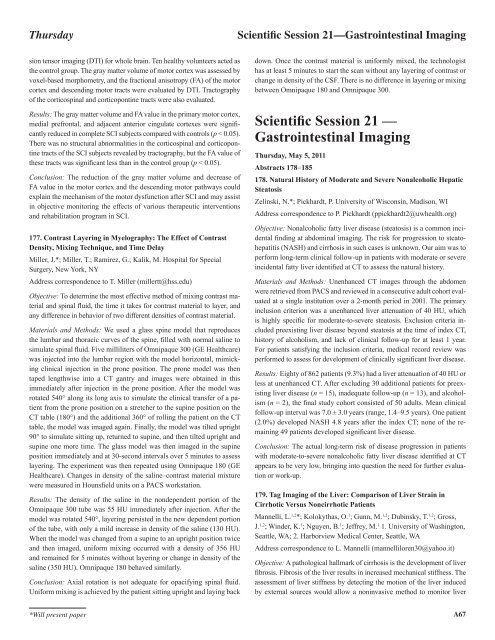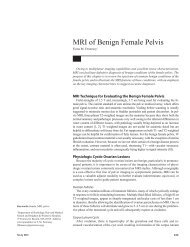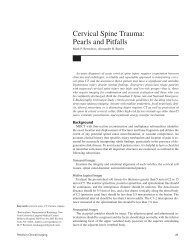Scientific Session 1 â Breast Imaging: Mammography
Scientific Session 1 â Breast Imaging: Mammography
Scientific Session 1 â Breast Imaging: Mammography
Create successful ePaper yourself
Turn your PDF publications into a flip-book with our unique Google optimized e-Paper software.
Thursday<strong>Scientific</strong> <strong>Session</strong> 21—Gastrointestinal <strong>Imaging</strong>sion tensor imaging (DTI) for whole brain. Ten healthy volunteers acted asthe control group. The gray matter volume of motor cortex was assessed byvoxel-based morphometry, and the fractional anisotropy (FA) of the motorcortex and descending motor tracts were evaluated by DTI. Tractographyof the corticospinal and corticopontine tracts were also evaluated.Results: The gray matter volume and FA value in the primary motor cortex,medial prefrontal, and adjacent anterior cingulate cortexes were significantlyreduced in complete SCI subjects compared with controls (p < 0.05).There was no structural abnormalities in the corticospinal and corticopontinetracts of the SCI subjects revealed by tractography, but the FA value ofthese tracts was significant less than in the control group (p < 0.05).Conclusion: The reduction of the gray matter volume and decrease ofFA value in the motor cortex and the descending motor pathways couldexplain the mechanism of the motor dysfunction after SCI and may assistin objective monitoring the effects of various therapeutic interventionsand rehabilitation program in SCI.177. Contrast Layering in Myelography: The Effect of ContrastDensity, Mixing Technique, and Time DelayMiller, J.*; Miller, T.; Ramirez, G.; Kalik, M. Hospital for SpecialSurgery, New York, NYAddress correspondence to T. Miller (millertt@hss.edu)Objective: To determine the most effective method of mixing contrast materialand spinal fluid, the time it takes for contrast material to layer, andany difference in behavior of two different densities of contrast material.Materials and Methods: We used a glass spine model that reproducesthe lumbar and thoracic curves of the spine, filled with normal saline tosimulate spinal fluid. Five milliliters of Omnipaque 300 (GE Healthcare)was injected into the lumbar region with the model horizontal, mimickingclinical injection in the prone position. The prone model was thentaped lengthwise into a CT gantry and images were obtained in thisimmediately after injection in the prone position. After the model wasrotated 540° along its long axis to simulate the clinical transfer of a patientfrom the prone position on a stretcher to the supine position on theCT table (180°) and the additional 360° of rolling the patient on the CTtable, the model was imaged again. Finally, the model was tilted upright90° to simulate sitting up, returned to supine, and then tilted upright andsupine one more time. The glass model was then imaged in the supineposition immediately and at 30-second intervals over 5 minutes to assesslayering. The experiment was then repeated using Omnipaque 180 (GEHealthcare). Changes in density of the saline–contrast material mixturewere measured in Hounsfield units on a PACS workstation.Results: The density of the saline in the nondependent portion of theOmnipaque 300 tube was 55 HU immediately after injection. After themodel was rotated 540°, layering persisted in the new dependent portionof the tube, with only a mild increase in density of the saline (130 HU).When the model was changed from a supine to an upright position twiceand then imaged, uniform mixing occurred with a density of 356 HUand remained for 5 minutes without layering or change in density of thesaline (350 HU). Omnipaque 180 behaved similarly.Conclusion: Axial rotation is not adequate for opacifying spinal fluid.Uniform mixing is achieved by the patient sitting upright and laying backdown. Once the contrast material is uniformly mixed, the technologisthas at least 5 minutes to start the scan without any layering of contrast orchange in density of the CSF. There is no difference in layering or mixingbetween Omnipaque 180 and Omnipaque 300.<strong>Scientific</strong> <strong>Session</strong> 21 —Gastrointestinal <strong>Imaging</strong>Thursday, May 5, 2011Abstracts 178-185178. Natural History of Moderate and Severe Nonalcoholic HepaticSteatosisZelinski, N.*; Pickhardt, P. University of Wisconsin, Madison, WIAddress correspondence to P. Pickhardt (ppickhardt2@uwhealth.org)Objective: Nonalcoholic fatty liver disease (steatosis) is a common incidentalfinding at abdominal imaging. The risk for progression to steatohepatitis(NASH) and cirrhosis in such cases is unknown. Our aim was toperform long-term clinical follow-up in patients with moderate or severeincidental fatty liver identified at CT to assess the natural history.Materials and Methods: Unenhanced CT images through the abdomenwere retrieved from PACS and reviewed in a consecutive adult cohort evaluatedat a single institution over a 2-month period in 2001. The primaryinclusion criterion was a unenhanced liver attenuation of 40 HU, whichis highly specific for moderate-to-severe steatosis. Exclusion criteria includedpreexisting liver disease beyond steatosis at the time of index CT,history of alcoholism, and lack of clinical follow-up for at least 1 year.For patients satisfying the inclusion criteria, medical record review wasperformed to assess for development of clinically significant liver disease.Results: Eighty of 862 patients (9.3%) had a liver attenuation of 40 HU orless at unenhanced CT. After excluding 30 additional patients for preexistingliver disease (n = 15), inadequate follow-up (n = 13), and alcoholism(n = 2), the final study cohort consisted of 50 adults. Mean clinicalfollow-up interval was 7.0 ± 3.0 years (range, 1.4–9.5 years). One patient(2.0%) developed NASH 4.8 years after the index CT; none of the remaining49 patients developed significant liver disease.Conclusion: The actual long-term risk of disease progression in patientswith moderate-to-severe nonalcoholic fatty liver disease identified at CTappears to be very low, bringing into question the need for further evaluationor work-up.179. Tag <strong>Imaging</strong> of the Liver: Comparison of Liver Strain inCirrhotic Versus Noncirrhotic PatientsMannelli, L. 1,2 *; Kolokythas, O. 1 ; Gunn, M. 1,2 ; Dubinsky, T. 1,2 ; Gross,J. 1,2 ; Winder, K. 1 ; Nguyen, B. 1 ; Jeffrey, M. 1 1. University of Washington,Seattle, WA; 2. Harborview Medical Center, Seattle, WAAddress correspondence to L. Mannelli (mannelliloren30@yahoo.it)Objective: A pathological hallmark of cirrhosis is the development of liverfibrosis. Fibrosis of the liver results in increased mechanical stiffness. Theassessment of liver stiffness by detecting the motion of the liver inducedby external sources would allow a noninvasive method to monitor liver*Will present paperA67
















